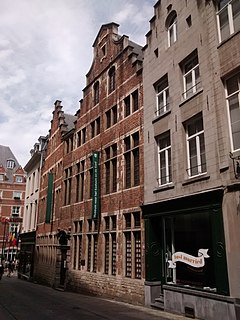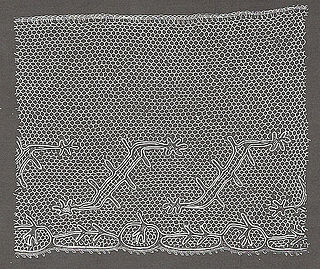 W
WAntwerp lace is a bobbin lace distinguished by stylized flower pot motifs on a six point star ground. It originated in Antwerp, where in the 17th century an estimated 50% of the population of Antwerp was involved in lace making. Antwerp lace is also known, from its familiar repeated motif, as Pot Lace— in Dutch Pottenkant or Potten Kant. It is sometimes said that the flowers were a depiction of the Annunciation lilies; however, the flowers were not limited to lilies.
 W
WBinche lace is a type of bobbin lace that originated in the town of Binche, Belgium. It is continuous, meaning it is made all at once, in one piece. It is generally made in strips 2 inches (5 cm) wide. Though typically it has no cordonnet outlining the design against the ground, occasional pieces are made with a very fine one, about the same thickness as the thread used in the pattern. The pattern in Binche lace is very detailed, with animal scenes and figures.
 W
WBruges lace is a fine white part lace made of cotton. It is made in pieces, with the designs later joined together to make the final lace.
 W
WBrussels lace is a type of pillow lace that originated in and around Brussels. The term "Brussels lace" has been broadly used for any lace from Brussels; however, the term strictly interpreted refers to bobbin lace, in which the pattern is made first, then the ground, or réseau, added, also using bobbin lace. Brussels lace is not to be confused with Brussels point, which is a type of needle lace, though is sometimes also called "Brussels lace".
 W
WBrussels tapestry workshops produced tapestry from at least the 15th century, but the city's early production in the Late Gothic International style was eclipsed by the more prominent tapestry-weaving workshops based in Arras and Tournai. In 1477 Brussels, capital of the duchy of Brabant, was inherited by the house of Habsburg; and in the same year Arras, the prominent center of tapestry-weaving in the Low Countries, was sacked and its tapestry manufacture never recovered, and Tournai and Brussels seem to have increased in importance.
 W
WThe Fashion and Lace Museum is a textile and fashion museum in Brussels, Belgium. The museum collections focus on lace, which is a traditional craft in Belgium. It was founded in 1977.
 W
WFlanders lace was made in Flanders, which was particularly well known for its bobbin lace. The supreme epoch of Flemish lace lasted from about 1550-1750.
 W
WLille lace was a type of bobbin lace that was made at Lille, also known as Rijsel. It was a lightweight lace popular in the eighteenth century in both black and white. It lacked the rich designs of Valenciennes lace. Its quality declined after the French Revolution, and by 1800 it was worn only by 'the most ordinary women'. In the first half of the nineteenth century the sketch-line designs, made only of gimp, were enclosed by a cloudy fond simple, relieved only by a scattering of tiny dots. After the French Revolution of 1848, little was made commercially.
 W
WMechlin lace or Point de Malines is an old bobbin lace, one of the best known Flemish laces, originally produced in Mechelen. Worn primarily during summer, it is fine, transparent, and looks best when worn over another color. Used for female clothing, it was popular until the first decade of the 20th century. It was made in Mechelen, Antwerp, Lier and Turnhout. It was used for coiffures de nuit, garnitures de corset, ruffles and cravats.
 W
WPoint de Gaze is a needle lace from Belgium named for the gauze-like appearance of the mesh ground. It was made from the early to mid 1800s to the 1930s.
 W
WValenciennes lace is a type of bobbin lace which originated in Valenciennes, in the Nord département of France, and flourished from about 1705 to 1780. Later production moved to Belgium, in and around Ypres. The industry continued onto the 19th century on a diminished scale. By the 19th century valenciennes lace could be made by machine.